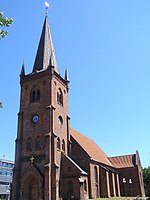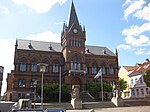Grejs River
Natura 2000 in DenmarkRivers of Jutland

Grejs River (Danish: Grejs Å) is an approximately 22-kilometre-long (14 mi) river in Vejle Municipality in Denmark. Its source is Fårup Lake, south of the village of Jelling. It starts by heading east through a tunnel valley, then turns south to run through Grejs Valley (Danish: Grejsdalen), the largest gorge in Denmark, until it reaches the city of Vejle. North of Vejle, it splits into two branches, Omløbsåen ("Bypass River") and Mølleåen ("Mill River"). Omløbsåen runs west around the city centre to meet Vejle River, while Mølleåen flows through the city and empties into Vejle River just south of the city centre.
Excerpt from the Wikipedia article Grejs River (License: CC BY-SA 3.0, Authors, Images).Grejs River
Gammelhavn, Vejle
Geographical coordinates (GPS) Address Nearby Places Show on map
Geographical coordinates (GPS)
| Latitude | Longitude |
|---|---|
| N 55.70549 ° | E 9.53439 ° |
Address
Gammelhavn
7100 Vejle
Region of Southern Denmark, Denmark
Open on Google Maps










